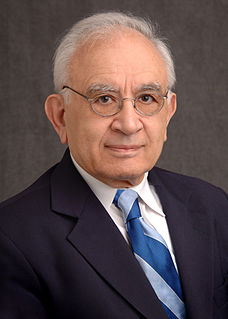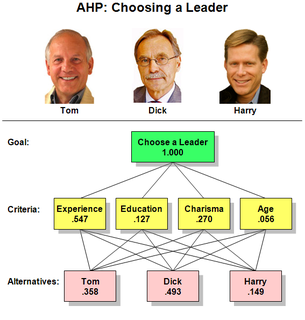Related Research Articles

Thomas L. Saaty was a Distinguished University Professor at the University of Pittsburgh, where he taught in the Joseph M. Katz Graduate School of Business. He is the inventor, architect, and primary theoretician of the Analytic Hierarchy Process (AHP), a decision-making framework used for large-scale, multiparty, multi-criteria decision analysis, and of the Analytic Network Process (ANP), its generalization to decisions with dependence and feedback. Later on, he generalized the mathematics of the ANP to the Neural Network Process (NNP) with application to neural firing and synthesis but none of them gain such popularity as AHP.

Multiple-criteria decision-making (MCDM) or multiple-criteria decision analysis (MCDA) is a sub-discipline of operations research that explicitly evaluates multiple conflicting criteria in decision making. Conflicting criteria are typical in evaluating options: cost or price is usually one of the main criteria, and some measure of quality is typically another criterion, easily in conflict with the cost. In purchasing a car, cost, comfort, safety, and fuel economy may be some of the main criteria we consider – it is unusual that the cheapest car is the most comfortable and the safest one. In portfolio management, managers are interested in getting high returns while simultaneously reducing risks; however, the stocks that have the potential of bringing high returns typically carry high risk of losing money. In a service industry, customer satisfaction and the cost of providing service are fundamental conflicting criteria.

In the theory of decision making, the analytic hierarchy process (AHP), also analytical hierarchy process, is a structured technique for organizing and analyzing complex decisions, based on mathematics and psychology. It was developed by Thomas L. Saaty in the 1970s; Saaty partnered with Ernest Forman to develop Expert Choice software in 1983, and AHP has been extensively studied and refined since then. It represents an accurate approach to quantifying the weights of decision criteria. Individual experts’ experiences are utilized to estimate the relative magnitudes of factors through pair-wise comparisons. Each of the respondents compares the relative importance each pair of items using a specially designed questionnaire.
AHP or Ahp may refer to:
The analytic network process (ANP) is a more general form of the analytic hierarchy process (AHP) used in multi-criteria decision analysis.
For group decision-making, the hierarchical decision process (HDP) refines the classical analytic hierarchy process (AHP) a step further in eliciting and evaluating subjective judgements. These improvements, proposed initially by Dr. Jang Ra include the constant-sum measurement scale for comparing two elements, the logarithmic least squares method (LLSM) for computing normalized values, the sum of inverse column sums (SICS) for measuring the degree of (in)consistency, and sensitivity analysis of pairwise comparisons matrices. These subtle modifications address issues concerning normal AHP consistency and applicability in the process of constructing hierarchies: generating criteria, classifying/selecting criteria, and screening/selecting decision alternatives.
The International Symposium on the Analytic Hierarchy Process (ISAHP) is a biennial conference on multi-criteria decision analysis, particularly the analytic hierarchy process (AHP) and its extension the analytic network process (ANP), both developed by Thomas L. Saaty, and the combination of these with other methods. It brings together researchers, teachers and users of AHP and ANP to share their research and practical experience in making decisions incorporating these two processes.
Decision-making software is software for computer applications that help individuals and organisations make choices and take decisions, typically by ranking, prioritizing or choosing from a number of options.
This is a worked-through example showing the use of the analytic hierarchy process (AHP) in a practical decision situation.
The Brown–Gibson model is one of the many techniques for multi-attribute decision making. The method was developed in 1972 by P. Brown and D. Gibson. This is one of the few models which integrates both objective and subjective factors in decision making.
The decision-making paradox is a phenomenon related to decision-making and the quest for determining reliable decision-making methods. It was first described by Triantaphyllou, and has been recognized in the related literature as a fundamental paradox in multi-criteria decision analysis (MCDA), multi-criteria decision making (MCDM) and decision analysis since then.
In decision-making, a rank reversal is a change in the rank ordering of the preferability of alternative possible decisions when, for example, the method of choosing changes or the set of other available alternatives changes. The issue of rank reversals lies at the heart of many debates in decision-making and multi-criteria decision-making, in particular.
This is a worked-through example showing the use of the analytic hierarchy process (AHP) in a practical decision situation.
Logical Decisions is decision-making software that is based on multi-criteria decision making.
Expert Choice is decision-making software that is based on multi-criteria decision making.
Decision Lens is online decision-making software that is based on multi-criteria decision making.
Criterium DecisionPlus is decision-making software that is based on multi-criteria decision making.
D-Sight is a company that specializes in decision support software and associated services in the domains of project prioritization, supplier selection and collaborative decision-making. It was founded in 2010 as a spin-off from the Université Libre de Bruxelles (ULB). Their headquarters are located in Brussels, Belgium.
PriEsT is an acronym for 'Priority Estimation Tool' which is an open-source decision-making software that implements the Analytic Hierarchy Process (AHP) method - a comprehensive framework for decision problems. PriEsT can assist decision makers in prioritizing the options available in a given scenario.
Ernest Forman is an American scholar and academic. He is a Professor of Decision Sciences at the George Washington University's School of Business. He is a co-founder, along with Thomas Saaty, of Expert Choice and developed the first commercial implementation of the Analytic Hierarchy Process.
References
- ↑ Saaty, T. L. (1980). "The Analytic Hierarchy Process". McGraw-Hill: New York.
{{cite journal}}: Cite journal requires|journal=(help) - ↑ Saracoglu, Burak Omer (2015). "An Ahp Application in the Investment Selection Problem of Small Hydropower Plants in Turkey". International Journal of the Analytic Hierarchy Process. 7 (2). doi: 10.13033/ijahp.v7i2.198 .